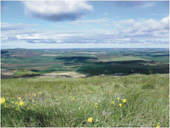Highlight
Using Interdisciplinary Research to Reconcile Social and Biological Needs in an Endangered Ecosystem
Achievement/Results
With NSF-IGERT funding, graduate students at the University of Idaho have made important contributions to understanding the social and biological dimensions of efforts to preserve the remaining remnants of a native prairie ecosystem.
The Palouse Prairie of southeastern Washington State and adjacent northern Idaho is a critically endangered ecosystem. Perhaps less than one percent of the native grasslands remain, primarily as small patches located on private lands. Now surrounded by an agriculturally dominated landscape, these remaining prairie remnants are threatened by rural residential development and the spread of invasive species. Private and public efforts to protect remaining prairie are hampered by inadequate understanding of the extent and biological status of the prairie, and of its importance to residents, which is requisite for creating and implementing regulations to protect it.
Individually, the University of Idaho IGERT students have each studied specific aspects of Palouse prairie. Their work has included mapping of the location of remnants in unprecedented detail, describing the distribution of various indicator species in prairie remnants, discovery of the presumed extinct endemic giant Palouse earthworm, and elucidating social perceptions of the prairie and the surrounding landscape. With IGERT support, these students have gone beyond their disciplinary projects. Working together they have created a geographic information systems (GIS)- based approach that reveals locations on the landscape where significant native biodiversity coincide with public perceptions of importance, whether based on aesthetics, sociological economic or historical factors. These areas of coincidence can inform public officials as they plan to manage projected development of the region.
This GIS-based approach resembles other recent efforts to understand landscapes simultaneously from biophysical and social environment points of view, but is unique in that the biological layers were developed based on current on-the-ground surveys conducted by the students and the social layer was developed using a semistructured interview that allowed participants to express as fully as possible their views on the Palouse landscape. Students and their faculty mentors have a paper presenting their research results accepted for publication in the refereed journal Ecology and Society, thereby contributing to the improvement of methods for achieving sustainable, ecologically sound community planning. The paper by Donovan, S., C. Looney, T. Hanson, Y. Sánchez de León, J.D. Wulhorst, S.D Eigenbrode, M. Jennings, J. Johnson-Maynard, and N.A. Bosque-Pérez is entitled Reconciling social and biological needs in an endangered ecosystem: the Palouse as a model for bioregional planning.
The IGERT study is also having important local impacts. The students have been invited to present their findings before the Latah County, Idaho Planning and Zoning Commission and the Whitman County, Washington Planning Commission. In addition, with a separate grant they have prepared a CD-ROM compiling information about the history, social perceptions, and biology of the Palouse prairie based on their research, and which will be made available to local residents.
Address Goals
Learning:
Through their interdisciplinary team efforts students have learned how to tackle complex environmental problems like those our society faces using innovative approaches and collaborative science. They have also learned the importance of transmitting their findings to a diverse audience including local planners so that results can be put to practical use.
Discovery:
IGERT funding has allowed this interdisciplinary effort to contribute substantively to ongoing and future efforts to preserve biodiversity while planning for growth and development in changing landscapes.











